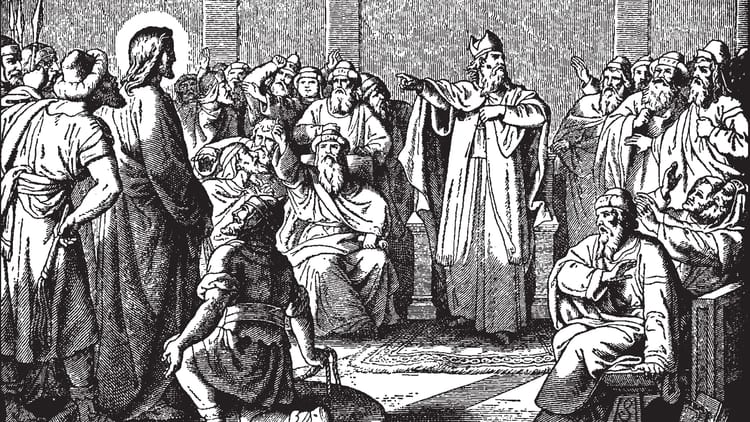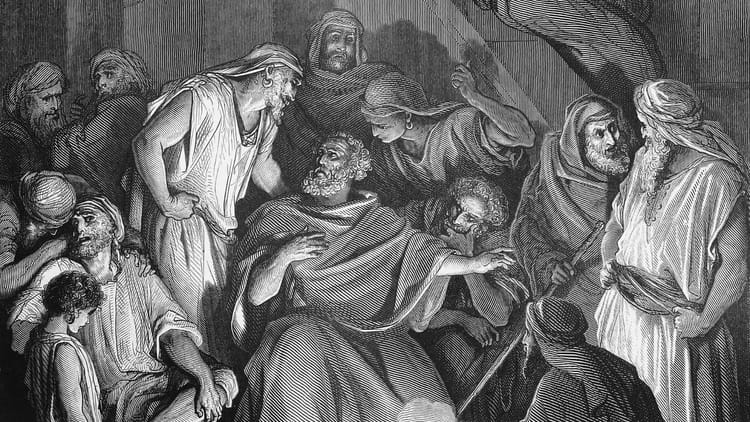Blindness (Mark 8:11-26)

One of the keys to reading the Bible is to notice details in the passage that are unusual, and to then begin to probe why they’re there. We say, “That was odd,” and then begin to look for clues for why things are different in that passage.
Today is a good example. There are many different miracles in the Gospel of Mark, but none like this one. In verses 22 to 26, Jesus heals a blind man. But something happens that doesn’t happen any other time in this Gospel or in any other. The man is only partially healed. Jesus partially heals him, and then like a physician who’s checking the results of surgery, asks, “Do you see anything?” Jesus never does that. He never has to check to see if his healing worked. But he does here. Jesus never has any trouble healing blind people any other time. All he has to say is, “Receive your sight.”
But surprisingly, this time, the healing doesn’t take the first time. The man says, “”I see people; they look like trees walking around” (Mark 8:24). If you’re a careful reader then you have to stop and ask exactly what is going on here. And I think you have to conclude that Jesus is giving us a picture of something.
And as we look at this passage and the two preceding events, we’re going to see three things. First, we’re going to see our spiritual condition. Then we’re going to see the two different types of this condition. Finally, we’re going to see the cure.
It’s very important that you take note of this passage because this is one that will both give you confidence and humble you at the same time. If you really understand this passage, you’ll be humbled, but at the same time you’ll be filled with hope that God is not done with you yet.
So let’s look first at what this passage reveals about our spiritual condition.
As we get to this passage, we’re getting near the climax of the first section of the Gospel of Mark. The big question as the Gospel unfolds is: who exactly is Jesus? It’s still actually the most important question we face, because if Jesus is indeed God’s Son, then it changes everything.
As we come to Mark 8, we encounter two groups of people who are dealing with this question. The first are the Pharisees. “The Pharisees came and began to question Jesus. To test him, they asked him for a sign from heaven” (Mark 8:11).
At first glance, this seems like an innocent request. There are lots of examples of authenticating signs in Scripture. When Moses went before Pharaoh, God gave him signs like his staff turning into a snake. “This is so that they may believe that the LORD, the God of their fathers–the God of Abraham, the God of Isaac and the God of Jacob–has appeared to you,” God said (Exodus 4:5).
Here, though, Jesus reacts very strongly to their request. He sighs, tells them that they won’t be getting any authenticating signs, and then takes off and leaves them. It’s almost like, at this point, Jesus writes off the Pharisees and says that there’s nothing more that can be done with them. He doesn’t try to convince them or reason with them. He’s done with them.
Why such a strong reaction?
You get a hint as Jesus talks to his disciples about the Pharisees. Jesus says in verse 15, “Be careful. Watch out for the yeast of the Pharisees and that of Herod.”
This makes absolutely no sense to us, so let me explain what Jesus is saying here. In those days, when you baked bread, you would bake with leaven or yeast so that the bread would rise. You would keep some of the bread containing yeast for the next batch. The problem is that the yeast could become tainted and spread poison when baked with the rest of the dough, and the contamination would spread from batch to batch. Jesus is saying that the Pharisees, and Herod, have a condition that will spread to them if they’re not careful.
And then Mark, with some humor, lets us know that it’s too late. They’ve already been contaminated. They think that Jesus is talking about something completely different. They completely miss the point. Jesus identifies the condition in verse 18: “Do you have eyes but fail to see, and ears but fail to hear? And don’t you remember?”
It’s no accident that Mark follows this with the story of blindness that is hard to heal. What Mark is telling us is this: that the blind man is a parable of the spiritual condition of both the Pharisees and the disciples. The enemies of Jesus (the Pharisees) and the friends of Jesus (the disciples) have exactly the same problem: spiritual blindness. They can’t see.
What Mark is telling us is that we are all in the same boat. We all suffer from the same problem. We have a spiritual perception issue. Years ago, Dr. Martyn Lloyd-Jones preached on this passage and said:
I have no hesitation in asserting again that one of the reasons why the Christian Church counts for so little in the modern world is that so many Christians are in this condition…I believe he dealt with the blind man as He did to give them a picture of themselves. He adopted this technique in the case before us, in order to enable the disciples to see themselves as they were. It goes beyond that, however: it is a permanent lesson always for God’s people.
We are all spiritual versions of Mr. Magoo. Do you remember that cartoon character? He was a wealthy, short-statured retiree who gets into a series of sticky situations as a result of his nearsightedness, compounded by his stubborn refusal to admit the problem. That’s exactly our problem too. Not only can’t we see, but we can’t see that we can’t see.
So this is our problem. As we read the story of the blind man in verses 22 to 26, we’re supposed to say, “That is a picture of me.” It’s not only a picture of the enemies of Jesus; it’s also a picture of his friends. Every person here is or has been spiritually blind. John Newton, the man who wrote the hymn Amazing Grace, once said, “There are many who stumble in the noon day, not for want of light, but for the want of eyes.” That includes all of us.
So we’ve seen what Jesus and Mark are telling us about our spiritual condition.
We then need to see that there are two kinds of spiritual blindness.
There is something in this passage that is very humbling. It’s that there really isn’t much difference between the friends of Jesus and the enemies of Jesus. Both are blind. This means that if you consider yourself to be a friend of Jesus, there really isn’t any room for feeling superior. You’re really no different from anyone else. One of the commentaries I read on this passage used this title for this passage: “Both opponents and supporters still have a lot to learn.” This should give us great humility. Spiritual blindness is not something those people have. It’s common to everybody. You’re either spiritually blind right now or you have been in the past.
It’s important to see this. Being an insider – even a disciple – is no guarantee that you understand. Proximity to Jesus is no guarantee that you have spiritual perception. You can go to church all your life and be spiritually blind as the enemies of Jesus.
So, in one sense, everyone is blind. Yet in this passage we see that there are two types of spiritual blindness. When Jesus confronts the Pharisees, you get the sense that there isn’t much hope for that type of blindness. Jesus abandons the Pharisees at this point. Why? It’s because they had already seen more than enough to demonstrate who Jesus was. They had chosen to reject Jesus even when the evidence was right in their face. They were already plotting his death. They weren’t looking to be convinced. They wanted an excuse for refusing to respond. They had chosen a permanent case of spiritual blindness.
Henry Fonda starred in a 1957 movie called Twelve Angry Men. A young man is on trial for the murder of his father. The twelve jurists walk into a hot, cramped jury room. All but one of the jurists (Henry Fonda) is ready to be done with the inconvenience of this trial. They’ve heard all they want to hear and seem unwilling to consider the possibility that the young man could be innocent. Only Henry Fonda’s character seems sensitive to the fact that something important hangs in the balance–a man’s life.
As Fonda’s character argues for reasonable doubt, the others don’t want to listen. One man points to the unique murder weapon as proof positive of the defendant’s guilt. Everyone seems convinced the knife is so rare and the boy’s story so implausible that the defendant must be guilty. Frustrated with Fonda as the lone holdout, he says, “Take a look at that knife. It’s a very unusual knife. I’ve never seen one like it.” The other men in the room murmur agreement.
“I’m just saying it’s possible,” says Fonda. One of the jurists steps forward angrily and shouts, “It’s not possible!” At that moment, Fonda reaches calmly into his pocket, pulls out an identical knife, pops the blade, and plants it into the middle of the table.
“Where did you get that?” one jurist asks. Fonda responds, “I went out walking for a couple of hours last night. I walked through the boy’s neighborhood. I bought that at a little pawn shop just two blocks from the boy’s house. It cost six dollars.”
Fonda’s character alone stopped long enough to take an honest, careful, unbiased look at the evidence. One by one, through honest struggle, all the jurists come to the same conclusion, and a young man facing death is set free. It’s possible to make up your mind, just like the Pharisees and just like these jurists, before honestly examining the evidence. If you willfully refuse to see what is right in front of you, there isn’t much hope for your blindness.
There’s another type of spiritual blindness. You see it with the disciples. They were blind, but you get the sense that there’s hope for them. Their type of blindness is almost comical. They’re so distracted by temporal things – really, by lunch – that they don’t get it. Jesus had fed nine thousand people with next to nothing, and they are worried about fixing lunch for 13. They are so trapped in their own little worlds, with their petty concerns, that they can’t see the kingdom of God breaking into history right in front of them.
We can’t be too hard on the disciples because we’re really not too different. There is something about us that tends to be distracted by our daily needs, so much so that we can’t see what God is doing all around us. We miss what God is doing because we’re too busy thinking about what we’re going to have for lunch.
That’s us, but there’s hope. Jesus doesn’t give up on the disciples. He asks them questions to lead them towards what they need to see. Gradually, and with great difficulty, they will see. There’s hope for these disciples. They will eventually see.
That’s why I love that Jesus healed the blind man in two stages. If Jesus had left him only halfway healed, he would have spent the rest of his life saying hi to trees and chopping down people. This should give us confidence. Even if we aren’t there yet, even if we can see only part way, we can know that God isn’t done with us yet. We will see clearly. Jesus can heal even the most difficult cases.
John Calvin puts it this way:
No one will travel so badly as not daily to make some degree of progress. This, therefore, let us never cease to do, that we may daily advance in the way of the Lord; and let us not despair because of the slender measure of success… Our labour is not lost when today is better than yesterday… If during the whole course of our life we seek and follow, we shall at length attain it, when relieved from the infirmity of the flesh we are admitted to the full fellowship of God.
These are the disciples that have been chosen by Christ himself. They still don’t get it, but they will. I told you that this passage humbles us, because we realize we aren’t so different. We’re all blind. But it should also encourage us, because Jesus will not leave us halfway blind. He will complete the work that he’s begun in us.
So you really have two kinds of blindness here. I’m afraid that there isn’t much hope for the first kind of blindness. But the story of the blind man, healed in stages, gives us hope that if Jesus has started to heal our blindness, then he will certainly finish his work.
So what, then, is the cure?
I want you to see this morning how encouraging this passage is. If you ended at verse 21, you’d be discouraged. The question that Jesus asked – “Do you still not understand?” – would be an open question. But the passage doesn’t end there. The passage ends with a picture of someone who is blind seeing. It may be slow, and it may come in stages, but some who are blind now will one day see clearly.
This morning there is hope for those of us who can’t see. There isn’t hope if you’re like the Pharisees. If you are looking for excuses not to believe, willfully turning your back on what you know to be true about God, then there is not much hope for your blindness.
But if you can relate to the disciples, there is hope for you. You may be distracted by immediate needs. You may find that you are falling flat on your face. Spiritually speaking you may find that things look as clear as they did for this blind man part way through his healing. People look like trees. But be thankful. If you have the smallest insight spiritually into the gospel, that is evidence that Jesus may be at work in your life restoring your spiritual eyesight so that you can see.
I’m going to close this morning by giving you some advice from Dr. Martyn Lloyd-Jones, who preached a famous sermon from this passage. It’s found in his book Spiritual Depression. He describes those who are half-way healed: “They seem to know enough about Christianity to spoil their enjoyment of the world, and yet they do not know enough to feel happy about themselves.” He says that the good news is that nobody has to stay in this condition. Lloyd Jones offers some advice if your spiritual eyesight is lacking, and you’d like to be healed.
First, he says, avoid making a premature claim that your blindness is healed. In other words, face up to reality. What a tragedy it would have been if the blind man had settled for seeing men as trees permanently. It would have been a big improvement, but it wouldn’t have been enough. So don’t settle for where you are right now. Admit that you have need to see better than you do.
Secondly: don’t be discouraged. You’re going to probably get frustrated. Lloyd-Jones says:
Such people come often come to me and say that they cannot see the Truth clearly. In their confusion they become desperate and ask, “Why cannot I see? The whole thing is hopeless.” They stop reading their Bible, they stop praying. The devil has discouraged many with lies. Do not listen to him.
When Jesus asks, “Do you see?” answer honestly, but don’t be discouraged.
Finally, come to Jesus. Submit to him and trust him to heal your spiritual eyesight. Jesus is our only hope; he will not leave anything incomplete.
Do you believe that the Son of God came from heaven and lived and did all that He did on earth, that He died on a Cross and was buried and rose again, that He ascended into heaven and sent the Holy Spirit, in order to leave us in a state of confusion? It is impossible. He came that we might see clearly, that we would know God…
Come to Him, come to His Word, wait upon Him, plead with Him, hold on to Him…[and] You will be able to say, “I see, I see in Him all that I need and more, and I know that I belong to Him.”
Let’s pray.
Father, this passage humbles us, because we see our problem. But it gives us confidence, because you know how to deal with our problem. Thank you that we can be “confident of this, that he who began a good work in you will carry it on to completion until the day of Christ Jesus” (Philippians 1:6).
We plead with you to heal our spiritual blindness. Let us see Jesus, and to see in Him all that we need and more We pray in his name. Amen.





